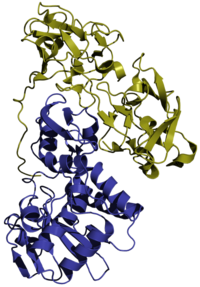
Photo from wikipedia
OBJECTIVE The present study aimed to investigate the cytotoxic effect of various extracts derived from Abrus precatorius Linn. leaves on rat L6 and human SK-N-MC neuroblastoma cell lines and determine… Click to show full abstract
OBJECTIVE The present study aimed to investigate the cytotoxic effect of various extracts derived from Abrus precatorius Linn. leaves on rat L6 and human SK-N-MC neuroblastoma cell lines and determine the secondary metabolites responsible for the cytotoxicity of Abrus precatorius. METHODS Successive solvent extraction of A.precatorius leaves was carried out using the Soxhlet apparatus with solvents such as petroleum ether, chloroform, ethyl acetate, and ethanol. HPTLC fingerprinting and LC-MS studies were performed to assess the presence of secondary metabolites, such as flavonoids and phenols, in the ethyl acetate extract. Furthermore, the cytotoxic effect of extracts was tested on rat skeletal muscle cell line L6 and human neuroblastoma cell line SK-N-MC using MTT assay. RESULTS The total phenolic content of ethyl acetate and ethanol extracts of A.precatorius were 72.67 and 60.73 mg, respectively, of GAE/g dry weight of the extract. The total flavonoid content of ethyl acetate and ethanol extract of A.precatorius were 107.33 and 40.66 mg of Quercetin equivalents/g dry weight of the extract. LCMS analysis demonstrated that the flavonoids in specific Naringenin, Diosmetin, Glycitin, and Genistein might play a prominent role in the cytotoxicity of A.precatorius. The cytotoxicity study revealed that the extracts of A.precatorius were non-toxic to rat L6 myotubes, and the IC50 values of the various extracts, such as APPE, APCH, APEA, and APET, were >100 µg/ml. The extracts exhibited cytotoxic activity against human neuroblastoma SK-N-MC cells, and the IC50 values of APPE, APCH, APEA, APET, and the standard drug "Cisplatin" were >100, >100, 64.88, >100, and 3.72 µg/ml, respectively. CONCLUSION It was concluded from the study that the extracts of Abrus precatorius were cytotoxic to neuroblastoma cell lines but non-toxic to normal cell lines. HPTLC and LC-MS studies confirmed that flavonoids in the ethyl acetate extract could be responsible for the biological activity.
Journal Title: Anti-cancer agents in medicinal chemistry
Year Published: 2023
Link to full text (if available)
Share on Social Media: Sign Up to like & get
recommendations!